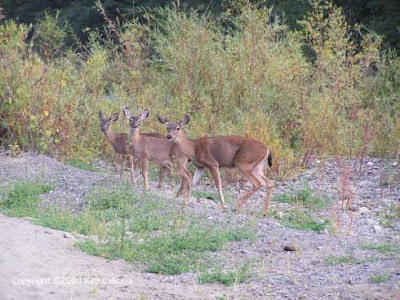

|
|
Hungry deer are a constant issue for foothill
gardeners. (Photo courtesy UC IPM)
|
It’s a constant question from foothill gardeners: What will deer NOT eat?
Find out during a free virtual workshop, “Living with Deer as a Foothill Gardener.”
Hosted by the UC Cooperative Extension Master Gardeners of Nevada County, this Zoom session is open to the public regardless of where they live. Set for 9 a.m. Saturday, Oct. 16, the workshop has no pre-registration; just click on the link and join in.
Deer rank among the most frustrating issues for foothill gardeners – and some Valley gardeners, too. These large mammals seem to always be hungry, and our gardens look so appetizing.
“Although there are no guarantees when gardening in deer country, there are ways to live with these browsers and have a lovely landscape and garden veggies as well,” say the master gardeners. “To learn more about managing deer in foothill gardens, join us to learn facts about the deer in our area and ways you can defend your gardens and landscape.”
Deer not only have big appetites; they can be just plain big. Mule deer, the most common species in the Sierra foothills and California’s only native deer species, can reach 6 feet tall and weigh 200 pounds. And they can jump!
Right now, deer are fattening up for the winter on acorns and other nutrient-rich foods. But they don’t care for lavender, rosemary or other pungent herbs. Think like a deer and, yes, you can redirect them away from your garden to native oaks and other more appropriate food sources.
More details and Zoom links (including passcode): https://ncmg.ucanr.org/ .
Comments
0 comments have been posted.Sacramento Digs Gardening to your inbox.
Sites We Like
Garden Checklist for week of Nov. 3
November still offers good weather for fall planting:
* If you haven't already, it's time to clean up the remains of summer. Pull faded annuals and vegetables. Prune dead or broken branches from trees.
* Now is the best time to plant most trees and shrubs. This gives them plenty of time for root development before spring growth. They also benefit from fall and winter rains.
* Set out cool-weather annuals such as pansies and snapdragons.
* Lettuce, cabbage and broccoli also can be planted now.
* Plant garlic and onions.
* Keep planting bulbs to spread out your spring bloom. Some possible suggestions: daffodils, crocuses, hyacinths, tulips, anemones and scillas.
* This is also a good time to seed wildflowers and plant such spring bloomers as sweet pea, sweet alyssum and bachelor buttons.
* Rake and compost leaves, but dispose of any diseased plant material. For example, if peach and nectarine trees showed signs of leaf curl this year, clean up under trees and dispose of those leaves instead of composting.
* Save dry stalks and seedpods from poppies and coneflowers for fall bouquets and holiday decorating.
* For holiday blooms indoors, plant paperwhite narcissus bulbs now. Fill a shallow bowl or dish with 2 inches of rocks or pebbles. Place bulbs in the dish with the root end nestled in the rocks. Add water until it just touches the bottom of the bulbs. Place the dish in a sunny window. Add water as needed.
* Give your azaleas, gardenias and camellias a boost with chelated iron.
* For larger blooms, pinch off some camellia buds.
* Prune non-flowering trees and shrubs while dormant.
* To help prevent leaf curl, apply a copper fungicide spray to peach and nectarine trees after they lose their leaves this month. Leaf curl, which shows up in the spring, is caused by a fungus that winters as spores on the limbs and around the tree in fallen leaves. Sprays are most effective now.